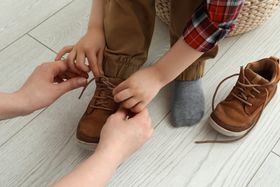What Causes Plantar Warts on Feet?
Explore the causes of plantar warts on feet, how they spread, and discover preventive measures to maintain healthy feet.
Updated August 21, 2023
Plantar warts, which are often confused with calluses, can be painful and are caused by specific strains of the human papillomavirus (HPV). They are particularly common among grade school-aged children and adolescents, especially athletes. Understanding what causes them, how they spread, and how to prevent them is essential to maintain healthy feet.
To help us learn more about plantar warts, we turned to Leah Alexander an experienced paediatrician who has been in practice for 23 years, treating patients ranging from infants to young adults.
What Are Plantar Warts?
Plantar warts are different from other types of warts in both their appearance and cause. Unlike sexually transmitted warts, which resemble small carrots, plantar warts typically begin as flesh-toned raised areas. As they grow, they develop a cauliflower-like appearance, sometimes featuring black dots in the grooves. This distinctive appearance helps to confirm that it is a wart and not just a callous. Depending on the location, they can cause pain while walking.
How Do Plantar Warts Develop?
Plantar warts are common among children, particularly those involved in barefoot activities such as wrestling, gymnastics, and swimming. They are easily transmitted either from person to person or via hard surfaces like floors or mats.
Activities That Promote Infection
- Swimming Pools: Walking barefoot around the pool is a common way to contract the virus.
- Communal Showers: Locker room showers and similar communal areas can be hotspots for the virus, especially if no foot protection is used.
- Sharing Shoes: Sharing shoes with an infected person is a potent avenue for the virus to spread among children.
Risk Factors and Spread Among Families
As families tend to share bathroom facilities, they definitely face a high risk of spreading the virus if one person is infected. Fortunately, it's fairly easy to take precautions and minimize the actual chance of spread.
Preventive Measures and Treatment
Good skincare is paramount to avoid plantar warts. Any break in the skin can allow the virus to enter, so daily moisturizing and healthy skincare habits are essential. Once a wart appears, it's crucial not to touch it, as this can spread the virus. Good hand hygiene must be maintained, and a doctor's intervention may be necessary for effective treatment.
Preventative measures at home include:
- Avoiding sharing shoes with an infected person.
- Regularly cleaning surfaces in showers and bathtubs.
- Discouraging infected individuals from walking barefoot at home.
Healthy Feet Ahead with Wart Care
Plantar warts on the feet are a common but preventable condition. Understanding their appearance, causes, and activities that may increase the risk is the first step toward prevention. Simple daily skincare routines, awareness about the infection process, and adherence to cleanliness can significantly reduce the likelihood of infection. Seeking professional medical intervention for treatment is often the best way to manage existing warts and prevent them from spreading to others in the household.
Related Articles

10 Best Winter Boots for Active Kids: Sturdy and Durable
Benjamin Aduwo
December 6, 2024

Why Orthopaedic Shoes Are a Game-Changer for Kids
Babafemi Adebajo
October 2, 2023

8 Best Summer Shoes for Kids: Cool & Comfort for Fun in the Sun
Jasrah Javed
December 6, 2024

Do Your Baby's Feet Point Outwards? Addressing Out-Toeing Concerns
Jasrah Javed
December 6, 2024

Plantar Fasciitis in Children: Causes, Symptoms, and Treatments
Jasrah Javed
January 22, 2025
Related Posts
Bhashwati Deb Barma
How to Identify Early Signs of Foot Drop in Children
Jasrah Javed
Top 5 Cute Pink Shoes for Little Girls
Babafemi Adebajo
Understanding the Waddling Gait in Children: Parent’s Guide
Babafemi Adebajo
Do You Need a Prescription for Orthopaedic Shoes?
Babafemi Adebajo
Why Do My Toddler’s Feet Look Yellow?
Babafemi Adebajo
